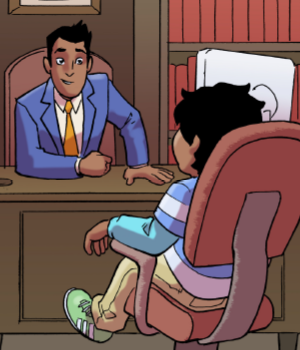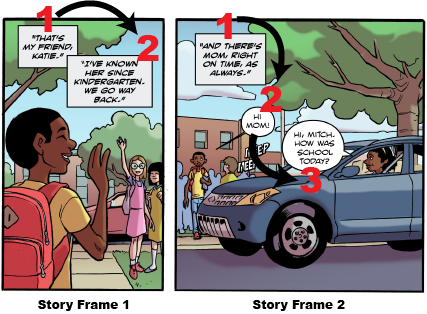Menu
Family and Dependency Court
Criminal Court
Human Trafficking
Children and Youth in Tribal Communities
A Guide for Parents and Caregivers
These materials were created specifically for children and youth in Tribal communities by Native authors and illustrators and are tailored to the needs of young children (ages 2 to 6), school-age children (ages 7 to 12), and teens (ages 13 to 18) who have been the victim and/or witness to a crime and are interacting with Tribal, state, and/or federal justice systems as a result. For each age group, there are separate books about the criminal legal system and the child welfare system, so you can choose the pieces that will be most helpful to your child and family.
Given the rich diversity among Native communities, these materials were designed to be relatable to the broadest possible audience; however, not every element will feel relevant to everyone. We encourage you to talk with your child about how your legal situation, culture, and community are similar and different to what happens in the stories, so that the experience can be as supportive, validating, and educational as possible for you and your child.
How to Read the Materials
The materials for school-age children (ages 7–12) and youth (ages 13–18) are formatted in a graphic novel style. Because not everyone is familiar with graphic novels, it may be helpful to explain the format to each young person before you begin reading.
Graphic novels are broken up into separate story frames or panels. A story frame is an individual drawing on a single section of the page, and each frame is separated by boxes. These frames are read in order from left-to-right like a traditional storybook and then top-to-bottom. The speech bubbles within each frame are most often read from left-to-right and then top-to-bottom, when applicable. See the graphic below for an example of two story frames from Marvelous Mitch.
Some of the novels use different color schemes and time markers to indicate flashback scenes, where the story transitions from the present day to an event that occurred in the past.
How to Use the Materials
It is so important that your child feels supported during this stressful time. Going through these materials together is one way that you and your child can connect and talk about what’s been happening, and that you can show your child how much you care.
- We recommend that you read through the materials first, before showing them to your child. If your child doesn’t yet read well, either you or someone working on their case, such as a therapist or advocate, can read the materials to them.
- Regardless of your child’s age, you play a very important role by helping them understand what they are reading and providing emotional support.
- The materials can be read all the way through at one time, or different sections can be used at different times, depending on your child’s age, your family’s situation, and how your child is feeling.
- As you read the story, you’ll come across activities along the way. Encourage your child to try the activities, because they teach coping skills that can help your child (and maybe you!) de-stress. You can also use the activities as reminders to take a break and check in with your child about how they’re feeling.
- Be aware that children can be triggered or upset by anything that reminds them of the traumas they have experienced. If your child becomes distressed, it is okay to take a break, offer support, and practice coping skills like deep breathing together.
- Feel free to make changes to the story so that it works well for your child. This might mean changing the details of what happened or using words that make more sense in your family and community.
- Ask your child questions to help connect the story to their feelings and experiences. For example: Is there someone like Gabi helping you? Brandon was angry when this happened; how do you think you would feel?
Tips for Supporting Your Child
Here are some ways to support your child while using these materials, and as they go through this experience:
- Let them know that it’s okay to have a lot of big feelings, or no feelings at all, and there are things they can do to feel better.
- Remind them that none of this is their fault.
- Tell them that they are not the only one who has gone through this; other kids and families have had these experiences, too.
- Remind them that there are people who support them, such as family members, friends, elders, Tribal leaders, caseworkers, advocates, therapists, and lawyers, and name those people together.
- Encourage your child to ask as many questions as they’d like, and to express their thoughts and feelings to you and to the grownups working on their case.
- Try to find times to laugh together, sing songs, play, and do physical things like taking a walk. These are important for taking care of yourself and each other.
- Limit your child’s exposure to adult conversations, as well as TV shows, movies, and other media that talk about violence or other upsetting topics.
- Consider allowing your child to make choices whenever possible, even about little things such as which shirt to wear, which errand to do first, or which parts of these materials to work on together. This helps children feel a sense of personal power and control again.
- Stick to your child’s usual daily routines as much as you can; knowing what to expect helps kids feel safer and more secure.
- Help your child feel connected with their culture and community as a source of strength and healing.
- Remind your child that they are strong and will get through this.
One more note: Because you are so important to your child, one of the best things you can do for them is to take care of yourself! That way you can support them as best you can. So, don’t forget to do things to help yourself feel better and heal, and ask any questions that you have, too.
You can also talk with your advocate or social worker about services and supports that might be helpful to your own healing and well-being.



